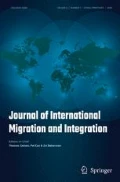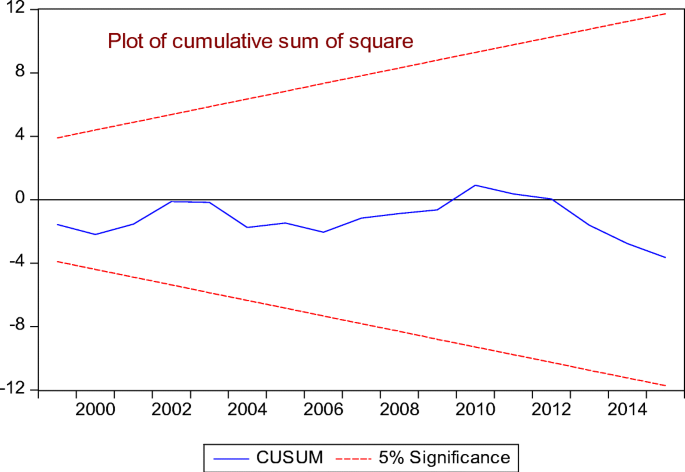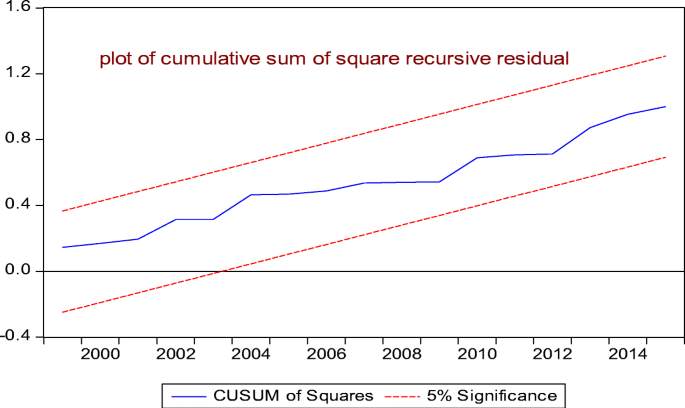Abstract
Despite the increasing importance of remittances in total international capital flows in Ethiopia, however, the short- and long-run relationships between remittances and economic growth has not been adequately studied. Existing few studies also did not resolve the nature of causality between remittances and economic growth. This study attempted to resolve these problems by employing the ARDL model and Granger causality test to investigate the short- and long-run effects and nature of causality of remittances on real GDP respectively for the period 1980 to 2015. The main results are as follows. First, remittance flow significantly improves real GDP in long run. Second, the effect of remittances in the short-run is negative. Third, there is unidirectional causality from remittances to economic growth. Fourth, short-run negative effect is higher than the long-run positive effect. A 1% increase in remittances increases real GDP by 1.13% in long run but reduces real GDP by 1.87% in the short run. This might be due to the fact that in the short run, remittances are mainly used for consumption smoothing and a high proportion of informal transfer of remittances. The policy implication of the results is that the government can extract the economic benefit of international remittance if it works on easing the remittance sending process and cost. This can be achived through devising a competitive financial system and setting coordination among government, banks, and migration offices. This can divert the remittance flows from the informal to the formal sectors.
Similar content being viewed by others
References
Abdih, Y., Chami, R., Dagher, J., & Montiel, P. (2012). Remittances and institutions: Are remittances a curse? World Development, 40(4), 657–666.
Abdullaev, R. (2011). Impact of remittances on economic growth in selected Asian and former Soviet Union countries. Lund University.
Adams Jr., R. H., & Cuecuecha, A. (2013). The impact of remittances on investment and poverty in Ghana. World Development, 50, 24–40.
Aggarwal, R., Demirgüç-Kunt, A., & Pería, M. S. M. (2011). Do remittances promote financial development?. Journal of Development Economics, 96(2), 255–264.
Ahortor, C. R., & Adenutsi, D. E. (2010). International remittances-The panacea for underdevelopment? A comparative panel data analysis of Sub Saharan Africa and Latin America. Journal of Applied Sciences, 10(4), 235–247.
Alkhathlan, K. A. (2013). The nexus between remittance outflows and growth: A study of Saudi Arabia. Economic Modelling, 33, 695–700.
Amuedo-Dorantes, C., & Pozo, S. (2014). Remittance income uncertainty and asset accumulation. IZA Journal of Labor & Development, 3(1), 1–24.
Bangake, C., Eggoh, J., & Semedo, G. (2019). Do remittances spur economic growth? Evidence from developing countries. The Journal of International Trade and Economic Development, 28(4), 391–418.
Barajas, A., Chami, R., Fullenkamp, C., Gapen, M., & Montiel, P. (2009). Do workers’ remittances promote economic growth? Working Paper No. 09/153, International Monetary Fund
Barro, R., & Sala-i-Martin, X. (2004). Economic growth (2nd ed.). MIT Press.
Bebbington, A. (1999). Capitals and capabilities: A framework for analyzing peasant viability, rural livelihoods and poverty. World Development, 27(12), 2021–2044.
Beijer, G. (1970). International and national migratory movements. International Migration Journal, 8(3), 93–109.
Bettin, G., & Zazzaro, A. (2012). Remittances and financial development: Substitutes or complements in economic growth? Bulletin of Economic Research, 64(4), 509–536.
Binford, L. (2003). Migrant remittances and (under) development in Mexico. Critical Anthropology, 23(3), 305–336.
Chami R., Fullenkamp C., and Jahjah S. (2003). Are immigrant remittances flows a source of capital for development? International Monetary Fund, Working paper WP/03/189
Davis, J. and Carr, D.L. (2010). The effects of migrant remittances on consumption in highland Guatemala. In Proceedings of the European Population Conference
De Has, H. (2007). Remittances, migration and social development. A conceptual review of the literature, Nueva York, United Nations. Research Institute for Social Development (Social Policy and Development Programme Paper 34).
Driffield, N., & Jonees, C. (2013). Impact of FDI, ODA and migrant remittance on economic growth in developing countries: A systems approach. European Journal of Development Research, 25(2013), 173–196.
Ellis, F. (2000). Rural Livelihoods and Diversity in Developing Countries. Oxford University Press.
Fayissa, B., & C. Nsiah. (2012). Financial development and remittances in Africa and the Americas: A panel unit-root tests and panel cointegration analysis.” Department of Economics and Finance. Working Paper Series 201201. Middle Tennessee State University.
Gebbisa, M. B. (2019). The impact of remittance on economic growth of Ethiopia. The Journal of Economics and Sustainable Development, 10(17), 1–11.
Golitsis, P., Avdiu, K., & Szamosi, L. T. (2018). Remittances and FDI effects on economic growth: A VECM and GIRFs for the case of Albania. Journal of East-West Business, 24(3), 188–211.
Hasan, G. M., & Shakur, S. (2017). Nonlinear effects of remittances on per capita GDP growth in Bangladesh. Economies, 5(3), 1–11.
Ikechi, K. S., & Anayochukwu, O. B. (2013). Migrant remittances and economic growth in Sub-Saharan Africa: Evidence from Nigeria and South Africa. Interdisciplinary Journal of Contemporary Research in Business, 4(10), 534–550.
Isaacs, L. (2018). Scaling up formal remittances to Ethiopia. International Organization for Migration.
Jawaid, S. T., & Raza, S. A. (2012). Workers’ remittances and economic growth in China and Korea: An empirical analysis., Iqra University/ http://mpra.ub.unimuenchende/39003/
Kindleberger, C. P. (1965). Europe’s postwar growth: The role of labor supply. Oxford University Press.
Kratou, H., & Gazdar, K. (2016). Addressing the effect of workers’ remittance on economic growth: Evidence from MENA countries. International Journal of Social Economics, 43(1), 51–70.
Kumar, R. R. (2012). Exploring the interactive effects of remittances, financial development and ICT in sub-Saharan Africa: An ARDL bound approach. African Journal of Economic Sustainable Development , 1(3)
Lipton and Michael. (1980). Migration from rural areas of poor countries: The impact on rural productivity and income distribution. World Development, 8, 10–20.
Lubambu, K. M. K. (2014). The impacts of remittances on developing countries. European Parliament. Retrieved from http://www.europarl.europa.eu/meetdocs/2014_2019/documents/acp/dv/study/studyen.pdf.
Lucas, R., & Stark, O. (1985). Motivations to remittances: Evidence from Botswana. Journal of Political Economy, 93(5), 901–918.
MacKinnon, J. G. (1996). Numerical distribution functions for unit root and cointegration tests. Journal of Applied Econometrics, 11(6), 601–618.
Maimbo, S., & Ratha, D. (2005). Remittances: Development impact and future prospects. The World Bank.
Massey, D., & Parrado, E. (1994). Migradollars: The remittances and savings of Mexican migrants to the USA. Population Research and Policy Review, 13(1), 3–30.
Matuzeviciute, K., & Butkus, M. (2016). Remittances, development level, and long-run economic growth. Economies, 4(4), 28.
McDowell, C., & de Haan, A. (1997). Migration and Sustainable Livelihoods: A critical review of the literature. University of Sussex, Brighton.
Meyer, D., & Shera, A. (2017). The impact of remittances on economic growth: An econometric model. Economia, 18(2), 147–155.
Olayungbo and Quadri Financial Innovation (2019) 5:9
Olufemi, A., & Ayandibu, A. (2014). Impact of remittances on development in Nigeria: Challenges and prospects. Journal of Social Antropology, 5(3), 311–318.
Oshota, S. O., & Badejo, A. A. (2014). The impact of remittances on economic growth in Nigeria: An error correction modeling approach. Zagreb International Review of Economics and Business, 17(2), 21–43.
Ozurumba, B. A. (2013). Migrant’s remittances and economic growth in sub-Saharan Africa: Evidence from Nigeria, Ghana and South Africa. Interdisciplinary Journal of Contemporary Research in Business, 4(10), 534–557.
Pesaran, M. H. (1997). The role of economic theory in modeling the long run. The Economics Journal, 107, 178–191.
Pesaran, M. H., Shin, Y., & Smith, R. J. (2001a). Bound testing approaches to the analysis of level relationships. Journal of Applied Economics, 16, 289–326.
Pesaran, M. H., Shin, Y., & Smith, R. J. (2001b). Bounds testing approaches to the analysis of level relationships. Journal of Applied Econometrics, 16(3), 289–326.
Phillips, P. C. B., & Perron, P. (1988). Testing for a unit in time series regression. Biometrica, 75, 335–346.
Qayyum, A., Muhammad, J., & Arif, U., (2008). Impact of remittances on economic growth and poverty: Evidence from Pakistan, MPRA Paper No.22911, http://mpra.ub.uni-muenchen.de/22941
Ratha, D. (2007). Leveraging remittances for international capital market access. World Bank.
Romer, P. M. (1986). Increasing returns and long-run growth. Journal of Political Economy, 94(5), 1002–1036.
Rubenstein, H. (1992). Migration. Development and remittances in rural Mexico. International Migration Journal, 30(2).
Russell, S. S. (1992). Migrant remittances and development. International Migration Journal, 30(3-4), 267–287.
Sami, B. M., & Mohamed, S. B. (2012). Through which channels can remittances spur economic growth in MENA countries? Economics, 6, 2012–2033.
Siddique, A., Selvanathan, E. A., & Selvanathan, S. (2012). Remittances and economic growth: Empirical evidence from Bangladesh, India and Sri Lanka. The Journal of Development Studies, 48(8), 1045–1062.
Sobiech, I. (2015) Remittances, finance and growth: does financial development foster remittances and their impact on economic growth?, FIW Working Paper Series, No 158.
Solow, R. M. (1956). A contribution to the theory of economic growth. The Quarterly Journal of Economics, 70(1), 65–94.
Stark, D. (1991). Path dependence and privatization strategies in East Central Europe. East European politics and societies, 6(1), 17–54.
Sutradhar, S. R. (2020). The impact of remittances on economic growth in Bangladesh, India, Pakistan and Sri Lanka. International Journal of Economic Policy Studies, 14(2020), 275–295.
Tchantchane, A., Rodrigues, G., & Fortes, P. C. (2013). An empirical study on the importance of remittance and educational expenditure on growth: Case of the Philippines. Applied Econometrics and International Development.
Todaro, M. P. (1969). A model of labor migration and urban unemployment in less developed countries. The American Economic Review, 59, 138–148.
Tolcha, T. D., & Rao, P. N. (2016). The impact of remittances on economic growth in Ethiopia. Indian Journal of Commerce and Management Studies, 7(2), 1–15.
Vadean, F., Randazzo, T., & Piracha, M. (2019). Remittances, labor supply and activity of household members left-behind. Journal of Development Studies, 55, 278–293.
World Bank. (2010). Survey on remittance income receivers in Ethiopia. Yasmeen, K: World Bank.
World Bank. (2017). Migration and remittances. Recent developments and outlook. Migration and development brief 27. Washington, D.C.: World Bank Group.
World Bank. (2018a). Migration and development brief 29. Washington, DC.
World Bank. (2018b). Migration and remittances data. [online] Available at: http://www.worldbank.org/…/migra tionr emitt ances diasp orais sues/…/migra tion-remit tance s-d.
World Bank. (2018c). World Development Indicators; World Bank: Washington, DC, USA; Available online: http://databank.worldbank.org/data/download/WDI_excel.zip.
World Development Indicators. (2020). Washington, DC: World Bank. Available online: http://databank.worldbank.org/data/download/WDI_excel.zip.
Author information
Authors and Affiliations
Corresponding author
Additional information
Publisher’s Note
Springer Nature remains neutral with regard to jurisdictional claims in published maps and institutional affiliations.
Appendix
Appendix
Rights and permissions
About this article
Cite this article
Yadeta, D.B., Hunegnaw, F.B. Effect of International Remittance on Economic Growth: Empirical Evidence from Ethiopia. Int. Migration & Integration 23, 383–402 (2022). https://doi.org/10.1007/s12134-021-00833-1
Accepted:
Published:
Issue Date:
DOI: https://doi.org/10.1007/s12134-021-00833-1





